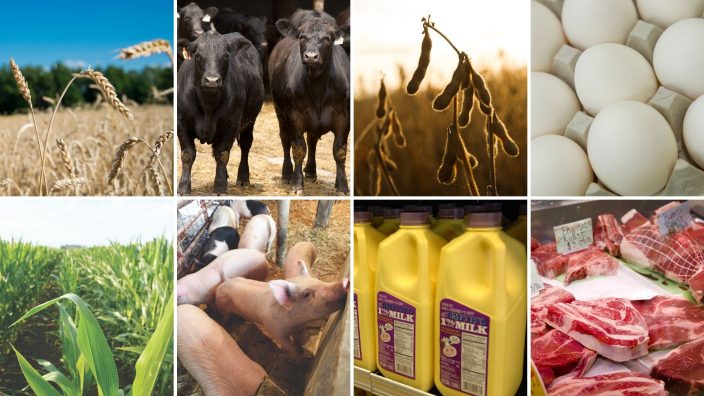Farmer’s Guide to Trucking Regulations available to Ohio Farm Bureau members
The guide includes a farm driver checklist, overview of state and federal regulations and exemptions, CDL qualifications and more.
Read More
When the COVID-19 pandemic started impacting everyday life in Ohio and across the country, no one was prepared. Everyone was told to shelter in place to help slow the spread of the virus so medical personnel wouldn’t be overwhelmed. Schools and restaurants closed overnight.
The well-oiled machine that is the food supply chain was suddenly left without half of its market, as demand for meat, dairy, eggs and more allocated for restaurants and schools instantly shifted as consumers ran to grocery stores and started stocking up. Repackaging half the food supply to send to grocery stores instead of restaurants is something that has never happened before, and the supply chain was not ready for the necessary transition.
More recently, worker illnesses have shuttered or slowed meat processing plants across the country. Concerns about a sustainable food supply continue to grow. Stories of milk dumping, plant closures and animal euthanasia are now headlines. Social media has exacerbated the debate over it all, often with more emotion than facts.
Various ag sectors are being hit hard at different times and in different ways. From a decline in gasoline impacting ethanol to trade uncertainties hitting corn and soybeans to major disruptions in key markets for proteins, very few aspects of agriculture have been spared by the global pandemic. Every commodity produced in Ohio has declined in value over the past three months. As of May 1, wheat was off 8%, soybean prices fell 13%, corn declined by 22% in value, live cattle lost 29% in value, milk lost 33% and hogs took the biggest hit, giving up 38% in market value since the first of the year.
According to the Ohio Pork Council via Datassential, consumers reduced spending at restaurants and other food service providers in March by as much as 65%.
In the meantime, cows are still producing milk, chickens are still laying eggs and pigs and cattle still need to be processed for beef and pork products.
This week President Trump signed an executive order to reopen meat packing facilities, citing the crucial need to feed the country. These plant closures were not a result of stay-at-home or shelter-in-place orders issued by the government, as meat processors and the rest of the food chain have been generally categorized as essential services.
American Farm Bureau President Zippy Duvall acknowledged the president’s decision and the never-before-seen challenges facing farmers.
“The COVID-19 pandemic has created an unprecedented crisis for American farmers. Farmers and ranchers face the heartbreaking decision to euthanize animals because of plant closures. It’s important for our elected leaders at all levels to understand the critical nature of this crisis,” Duvall said.
These plants will be mandated to use guidelines to ensure worker safety. According to USDA, the Centers for Disease Control and Prevention (CDC) of the Department of Health and Human Services and the Occupational Safety and Health Administration (OSHA) of the Department of Labor have put out guidance for plants to implement to help ensure employee safety to reopen plants or to continue to operate those still open. Under the Executive Order and the authority of the Defense Production Act, USDA will work with meat processing to affirm they will operate in accordance with the CDC and OSHA guidance, and then work with state and local officials to ensure that these plants are allowed to operate to produce the meat protein that Americans need. USDA will continue to work with the CDC, OSHA, FDA, and state and local officials to ensure that facilities implementing this guidance to keep employees safe can continue operating.
The painful decision to euthanize an animal or dump milk because there is no other way weighs heavily on each individual farmer, but the reasons leading up to such a decision are just as worrisome.
“We have been concerned about the serious disruptions and volatility we have seen in our livestock markets,” said Jack Irvin, OFBF senior director of national and state policy. He noted Farm Bureau has been pushing the Commodity Futures Trading Commission (CFTC), the U.S. Department of Agriculture and congressional leaders to investigate why there has been such a stark disruption in livestock markets.
“It is no secret that with strong retail prices and low prices at the farm gate, farmers are getting squeezed,” he said. “And with major livestock processing facilities being idled or reducing capacity because of COVID-related issues, that clearly is having a major impact on our farms.”
Farm Bureau also has been actively pursuing direct assistance for all farmers, including for those in the livestock industry. Recently, the U.S. Department of Agriculture announced a program that will provide $16 billion in direct payments to farmers of all types and sizes, along with $3 billion to purchase agriculture products to help consumers in need. Nearly $10 billion is set aside specifically for livestock farmers.
“We do not know the details yet on how the programs will work, but we are pushing USDA to act quickly and decisively,” Irvin said.
From the onset of the state’s efforts to stop the spread of COVID-19, Ohio Farm Bureau has shared the concerns and the needs of rural Ohio and the agriculture community with government leaders. Farm Bureau worked closely with Gov. DeWine and made sure that those in Ohio’s food supply system were deemed essential, allowing anyone from farmers to truckers to grocers to continue the important work of keeping food readily available.
Thanks to member feedback to the Farm, Food and Agribusiness COVID-19 Impact Survey, Farm Bureau has been able to work on the countless other issues that are being caused by this crisis. The most pressing issue raised is the disruption of distribution channels. When limits were being put on how much milk consumers could buy at the same time milk was being dumped on the farm, Farm Bureau worked with American Dairy Association Mideast to contact stores directly and had most of those limits lifted.
Respondents said cashflow was a major concern, so Farm Bureau advocated for additional funds for the Paycheck Protection Program and continues the dialogue with USDA to make sure funds from assistance programs allocated for agriculture get to where they are needed the most. There is still much more work to be done, and Farm Bureau continues its efforts on all fronts as we all navigate these trying times.
Farm Bureau’s positions are member driven through the policy development process. The lessons of the COVID crisis are being analyzed now and will be for years. As always, members are invited to engage in this process in a thoughtful, fact driven manner. In the months to come, the current Farm Bureau state and federal policy will be reviewed, taking into consideration a big picture look at the country’s food system and what has worked well and what hasn’t.


The guide includes a farm driver checklist, overview of state and federal regulations and exemptions, CDL qualifications and more.
Read More


ODA will enroll 500,000 acres into the program for a two-week sign-up period, beginning April 22, 2024, through May 6, 2024. Contact local SWCD offices to apply.
Read More

Katie Share of Columbus has been named ExploreAg and Youth Development Specialist for Ohio Farm Bureau.
Read More

Mary Klopfenstein of Delphos has been named Young Ag Professional and Ag Literacy Program Specialist for Ohio Farm Bureau.
Read More

The plan has been updated to give sole proprietors access to more rate stability and a smart solution that offers potential savings on health care.
Read More

The American Farm Bureau Federation, in partnership with Farm Credit, is seeking entrepreneurs to apply online by June 15 for the 2025 Farm Bureau Ag Innovation Challenge.
Read More

Adele Flynn of Wellington has been elected treasurer of the Ohio Farm Bureau Federation and now holds the third highest elected office in Ohio’s largest and most influential farm organization.
Read More

Producers are urged to work with their veterinarian to practice enhanced biosecurity measures and review and limit cattle movements within production systems.
Read More

The changing seasons bring with them the need to thoroughly inspect pole barns for any damages that may have occurred during the winter months.
Read More

Hundreds of Ohio businesses and sole proprietors are raving about Ohio Farm Bureau’s Health Benefits plan with lower, predictable costs and easy enrollment and administration options.
Read More